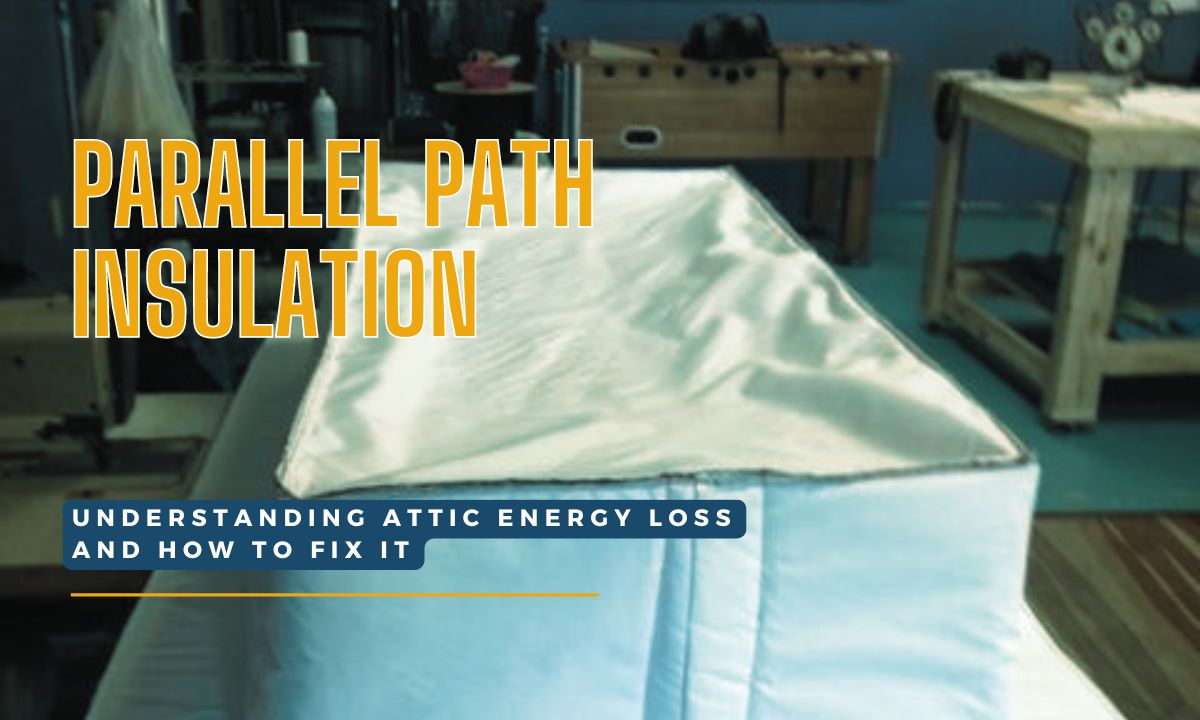
18 Dec Parallel Path Insulation: Understanding Attic Energy Loss and How to Fix It
When it comes to energy efficiency in your home, the attic often plays a crucial role. However, many homeowners overlook one significant problem: an un-insulated and unsealed attic door. If your attic access isn’t properly insulated, it can drastically reduce the overall efficiency of your home’s insulation barrier. To understand how this happens, let’s break it down with an analogy.
Imagine you have a bucket filled with water. If the bucket is watertight, no water escapes. But what happens if you drill 30 tiny holes in the bottom? Gravity will pull the water through these small holes, leaking out slowly. Now, if you take a much larger drill bit and add a single one-inch hole to the bottom of the bucket, the water drains much faster. That large hole represents a massive inefficiency compared to the tiny holes.
This scenario mirrors how an un-insulated attic door affects your home’s energy efficiency. Even though it’s just a small portion of the overall space, it creates a significant energy leak. In this article, we’ll explore how to calculate the impact of an un-insulated attic door on your home’s insulation and why addressing this issue should be a top priority.
The Concept of Parallel Path Insulation
Parallel path insulation refers to the varying levels of insulation within a single area, like your attic. When part of the attic has high-quality insulation and another part is poorly insulated (or not insulated at all), energy will escape through the weaker section. This concept is vital to understanding the overall efficiency of your attic insulation.
To explain this further, let’s break down the math.
Calculating Energy Loss in an Attic with an Un-insulated Door
Let’s assume you have an attic that’s 800 square feet and is insulated to an R-value of 50 (R-value measures insulation effectiveness; the higher the number, the better). Now, imagine that the attic has a small access door that measures 24 x 33 inches, which equals roughly 6 square feet. This door is un-insulated, offering an R-value of just 1.
Here’s how the calculation works:
- Ravg = the inverse of Uavg (which is the overall heat transfer coefficient)
- Uavg = [(1/R1) x A1 + (1/R2) x A2] / Total Area
Where:
- R1 is the R-value of the well-insulated part of the attic (R50)
- A1 is the area of the insulated part of the attic (794 sq ft)
- R2 is the R-value of the un-insulated door (R1)
- A2 is the area of the un-insulated door (6 sq ft)
Now, plug in the numbers:
Uavg = [(1/50) x 794 + (1/1) x 6] / 800
Uavg = (0.02 x 794 + 1 x 6) / 800 = 0.062
The new R-value (Ravg) for the entire attic space is the inverse of Uavg:
Ravg = 1 / 0.062 = 16.13
That means the overall R-value of the attic insulation drops from 50 to just 16, simply because of that small un-insulated door. Essentially, you’re losing about two-thirds of your attic’s energy efficiency due to a minor oversight.
The Impact of Energy Loss on Your Home
So, what does this drop in R-value mean for your home’s energy consumption? It’s substantial. With such a low R-value, heat will escape much more rapidly through your attic access, increasing your energy bills and forcing your HVAC system to work harder. This is why addressing the issue of an un-insulated attic door can offer significant energy savings.
Why You Should Prioritize Sealing Your Attic Door
Fixing an un-insulated attic door is one of the most cost-effective energy efficiency upgrades you can make. It’s what experts often call “low-hanging fruit”—easy to address and offering a quick return on investment.
Here’s the key: sealing and insulating your attic access can give you an R12 boost across the entire attic space. To put this into perspective, sealing the attic door alone could save you 200–250 cubic feet per minute (CFM) in conditioned air, which is a massive reduction in energy loss.
Cost Comparison: Attic Door Insulation vs. Other Home Improvements
Let’s take a look at how this compares to other common home upgrades:
- Replacing a standard 2-foot by 5-foot wooden window with an energy-efficient, double-pane window might save you 30–50 CFM of air leakage, but it could cost you $400–$500 per window.
- In contrast, insulating your attic door can save you up to 250 CFM for just $200–$350, depending on whether you go the DIY route or hire a contractor.
Essentially, insulating your attic door offers five to seven times the CFM reduction for a fraction of the cost compared to upgrading windows. And if you were to replace multiple windows, the cost would quickly climb into the thousands, still without delivering the same level of efficiency as sealing your attic access.
How Attic Zipper Solves the Problem
Now that we understand the impact of an un-insulated attic door, let’s talk about the solution: Attic Zipper. This innovative product is specifically designed to seal and insulate your attic access effectively. It provides a thermal barrier that prevents heat from escaping through your attic door, ensuring that the rest of your attic insulation can perform at its best.
Attic Zipper is not only efficient but also compliant with IRC (International Residential Code) and IECC (International Energy Conservation Code) standards, thanks to its included batt straps. These straps allow you to add as much insulation as needed to meet regulatory requirements, making it a versatile solution for any home.
Why You Should Invest in Attic Zipper
Here’s why Attic Zipper should be your go-to solution:
- Energy Savings: By properly sealing your attic access, you can immediately boost the R-value of your entire attic, reducing energy bills and improving overall comfort in your home.
- Easy Installation: Whether you choose to install it yourself or hire a professional, Attic Zipper is a straightforward, hassle-free upgrade.
- Code Compliance: The product meets IRC and IECC insulation standards, ensuring that your home stays energy-efficient and up to code.
- Cost-Effective: Compared to other home improvement projects, insulating your attic access with Attic Zipper is an affordable way to significantly reduce energy loss.
Don’t wait for your energy bills to spike. Visit atticzipper.com/shop today to order your Attic Zipper and start saving on energy costs. It’s a small investment with a big return.
Conclusion
The attic door might seem like a small, insignificant part of your home’s energy system, but as we’ve seen, it can have a massive impact on your overall insulation efficiency. By addressing this simple issue with products like Attic Zipper, you can dramatically improve your home’s energy performance without breaking the bank.
Ready to stop energy from leaking through your attic door? Head over to atticzipper.com/shop to find the perfect insulation solution for your home today!
FAQs
- What is parallel path insulation? Parallel path insulation occurs when different parts of an area have varying levels of insulation. Energy will escape more easily through the weaker insulated sections.
- How does an un-insulated attic door affect my energy bills? An un-insulated attic door can drastically reduce the overall R-value of your attic insulation, allowing heat to escape and increasing your energy bills.
- Is it expensive to insulate my attic door? No, insulating your attic door with a product like Attic Zipper is an affordable solution, costing around $200 for DIY installation or $350 with a contractor.
- How much energy can I save by insulating my attic access? Insulating your attic door can save up to 200–250 CFM of conditioned air, which can lead to significant reductions in energy bills.
- Where can I purchase Attic Zipper? You can purchase Attic Zipper products directly from their website at atticzipper.com/shop.



